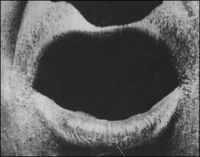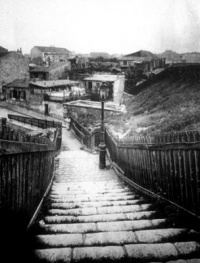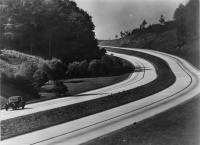Early twentieth century
From The Art and Popular Culture Encyclopedia
| Revision as of 09:23, 24 July 2010 Jahsonic (Talk | contribs) (→See also) ← Previous diff |
Current revision Jahsonic (Talk | contribs) (→Visual art) |
||
| Line 1: | Line 1: | ||
| + | [[Image:Great Train Robbery still, public domain film.jpg|thumb|left|200px|''[[Great Train Robbery]]'' ([[1903]]) [[western film]]]] | ||
| [[Image:The Big Swallow.jpg|thumb|right|200px|Extreme [[close-up]] from the movie "[[The Big Swallow]]" ([[1901]]), produced and directed by [[James Williamson]] (1855-1933)]] | [[Image:The Big Swallow.jpg|thumb|right|200px|Extreme [[close-up]] from the movie "[[The Big Swallow]]" ([[1901]]), produced and directed by [[James Williamson]] (1855-1933)]] | ||
| [[Image:Danae.jpg|thumb|right|200px|''[[Danaë]]'' ([[1907]]-[[1908|08]]) - [[Gustav Klimt]]]][[Image:Eugene Atget.jpg|thumb|right|200px|''Rue de la Colonie'' ([[1900]]) - [[Eugène Atget]]]] | [[Image:Danae.jpg|thumb|right|200px|''[[Danaë]]'' ([[1907]]-[[1908|08]]) - [[Gustav Klimt]]]][[Image:Eugene Atget.jpg|thumb|right|200px|''Rue de la Colonie'' ([[1900]]) - [[Eugène Atget]]]] | ||
| - | [[Image:Great Train Robbery still, public domain film.jpg|thumb|right|200px|''[[Great Train Robbery]]'' ([[1903]]) [[western film]]]] | ||
| [[Image:Blue Horse by Franz Marc.jpg|thumb|200px|''[[Blue Horse]]'' ([[1911]]) by [[Franz Marc]]]] | [[Image:Blue Horse by Franz Marc.jpg|thumb|200px|''[[Blue Horse]]'' ([[1911]]) by [[Franz Marc]]]] | ||
| - | [[Image:The Seashell 1912) - Odilon Redon.jpg|thumb|200px|right|''[[Shell|The Seashell]]'' ([[1912]]) by [[Odilon Redon]]]] | + | [[Image:The Seashell 1912) - Odilon Redon.jpg|thumb|200px|right|''[[La coquille (The Shell, Odilon Redon)|The Shell]]'' ([[1912]]) by [[Odilon Redon]]]] |
| [[Image:Calavera de la Catrina by Posada.jpg|right|thumb|200px| | [[Image:Calavera de la Catrina by Posada.jpg|right|thumb|200px| | ||
| ''[[Calavera]] de la [[Catrina]]'' (before [[1913]]) by [[Posada]]]] | ''[[Calavera]] de la [[Catrina]]'' (before [[1913]]) by [[Posada]]]] | ||
| Line 16: | Line 16: | ||
| {{Template}} | {{Template}} | ||
| - | The '''early 20th century''' comprise the [[1900s]], [[1910s]], [[1920s]], [[1930s]] and the [[interbellum]]. The period followed the [[fin de siecle]]. Cinema is still mainly silent. It is the floruit of Paris and Berlin as modern metropolises and the rise of [[artistic Montparnasse]]. The period was marked by [[WWI]] and ended with [[WWII]]. | + | The '''early 20th century''' comprise the [[1900s]], [[1910s]], [[1920s]], [[1930s]] and the [[interbellum]]. The period followed the [[fin de siècle]]. Cinema is still mainly silent. It is the floruit of Paris and Berlin as modern metropolises and the rise of [[artistic Montparnasse]]. The period was marked by [[WWI]] and ended with [[WWII]]. |
| ==1900s== | ==1900s== | ||
| :''[[1900s]]'' | :''[[1900s]]'' | ||
| Line 133: | Line 133: | ||
| *1934 ''[[The Ethics of Sexual Acts]]'' (1934) - [[René Guyon]] | *1934 ''[[The Ethics of Sexual Acts]]'' (1934) - [[René Guyon]] | ||
| *1935 ''[[The Work of Art in the Age of Mechanical Reproduction]]'' - Walter Benjamin | *1935 ''[[The Work of Art in the Age of Mechanical Reproduction]]'' - Walter Benjamin | ||
| - | *1936 ''[[Modern Times]]'' (1936) - Charlie Chaplin | + | *1936 ''[[Modern Times (film)|Modern Times]]'' (1936) - Charlie Chaplin |
| *1937 Germany, [[Degenerate Art]] exhibition, ''[[Guernica]]'' (1937) - Pablo Picasso | *1937 Germany, [[Degenerate Art]] exhibition, ''[[Guernica]]'' (1937) - Pablo Picasso | ||
| *1938 [[Hitler]] man of the year in Time Magazine | *1938 [[Hitler]] man of the year in Time Magazine | ||
| Line 141: | Line 141: | ||
| *''[[M]]'' (1931) - Fritz Lang | *''[[M]]'' (1931) - Fritz Lang | ||
| *''[[Extase]]'' (1932) | *''[[Extase]]'' (1932) | ||
| - | *''[[Freaks]]'' (1932) | + | *''[[Freaks (1932 film)|Freaks]]'' (1932) |
| *''[[Vampyr]]'' (1932) - Carl Theodor Dreyer | *''[[Vampyr]]'' (1932) - Carl Theodor Dreyer | ||
| *''[[Duck Soup]]'' (1933) - Leo McCarey | *''[[Duck Soup]]'' (1933) - Leo McCarey | ||
| *''[[The Black Cat]]'' (1934) | *''[[The Black Cat]]'' (1934) | ||
| - | *''[[Modern Times]]'' (1936) | + | *''[[Modern Times (film)|Modern Times]]'' (1936) |
| *''[[Reefer Madness]]'' (1936) | *''[[Reefer Madness]]'' (1936) | ||
| *''[[Things to Come]]'' (1936) | *''[[Things to Come]]'' (1936) | ||
| Line 175: | Line 175: | ||
| === Visual art === | === Visual art === | ||
| - | * '''[[1939 in art]]''' - Birth of [[Spider Martin]] | + | |
| - | * '''[[1938 in art]]''' - Birth of [[Joan Brown]], [[Brice Marden]], [[Eugene J. Martin]], Death of [[Ernst Ludwig Kirchner]], [[William Glackens]] | + | |
| - | * '''[[1937 in art]]''' - Birth of [[David Hockney]], [[Ronald Davis]], [[Red Grooms]], [[Robert Mangold]], [[Larry Zox]], [[Pablo Picasso]] paints ''[[Guernica]]'' | + | |
| - | * '''[[1936 in art]]''' - Birth of [[Richard Estes]], [[Eva Hesse]], [[Frank Stella]], | + | |
| - | * '''[[1935 in art]]''' - Birth of [[Jim Dine]], [[Don McCullin]], Death of [[Charles Demuth]], [[Paul Signac]] | + | |
| - | * '''[[1934 in art]]''' - Birth of [[Patrick Ireland]] | + | |
| - | * '''[[1933 in art]]''' - Birth of [[Sam Gilliam]], [[Yoko Ono]], [[James Rosenquist]], [[Dan Flavin]] | + | |
| - | * '''[[1932 in art]]''' - Birth of [[Howard Hodgkin]], [[Paul Caponigro]] | + | |
| - | * '''[[1931 in art]]''' - Births of [[Frank Auerbach]], [[Bridget Riley]], [[Tom Wesselmann]] | + | |
| - | * '''[[1930 in art]]''' - Birth of [[Jasper Johns]], Death of [[Jules Pascin]] | + | |
| ==Literature == | ==Literature == | ||
Current revision



(Photo by Walery)

|
Related e |
|
Featured: |
The early 20th century comprise the 1900s, 1910s, 1920s, 1930s and the interbellum. The period followed the fin de siècle. Cinema is still mainly silent. It is the floruit of Paris and Berlin as modern metropolises and the rise of artistic Montparnasse. The period was marked by WWI and ended with WWII.
Contents |
1900s
- Pablo Picasso paints Les Demoiselles d'Avignon, considered by some to be the birth of modern art.
- Joseph Conrad publishes Heart of Darkness
- Thomas Mann publishes Buddenbrooks
- Cubism
- Fauvism
- Joseph Conrad publishes the novella Heart of Darkness in 1902, after the serial release in 1898
- Joseph Conrad publishes The Secret Agent in 1907
- Jack London publishes The Call of the Wild in 1903
- Serbian writers use the Belgrade literary style, an Ekavian writing form which set basis for the later standardization of the Serbian language
1910s
- Radio programming becomes popular
- Flying Squadron promotes temperance movement in the U.S.
- The first U.S. feature film, Oliver Twist, was released in 1912
- The first gangster movie, D. W. Griffith's The Musketeers of Pig Alley was released in 1912
- Hollywood replaces the East Coast as the center of the movie industry
- Charlie Chaplin débuts his trademark mustached, baggy-pants 'Little Tramp' character in Kid Auto Races At Venice in 1914
- The first African-American owned studio, The Lincoln Motion Picture Company, was founded in 1917
- The four Warner brothers, Jack, Albert, Harry and Samuel, opened their first West Coast studio in 1918
- First crossword puzzle
- Jazz music begins to become popular
Film
- Aufklaerungsfilme
- Quo Vadis? by Enrico Guazzoni
- Fantômas (1913 - 1914) film serial
- Cabiria (1914) by Giovanni Pastrone
- Les Vampires (1915) - Louis Feuillade
- A Fool There Was (1915) - Frank Powell
Visual art
- end of Art Nouveau and beginning of Art Deco
- September Morn (1912) by Paul Emile Chabas
- Fountain (1917) by Duchamp
- Blue Horse (1911) by Franz Marc
- Me and my Village (1911) by Marc Chagall
- Armory show (1913)
- Piazza d'Italia (1913) by Giorgio de Chirico
- Centrale elettrica (1914) by Antonio Sant'Elia
- In 1914, suffragette Mary Richardson damages Velasquez painting Rokeby Venus
- Red and Blue Chair (1918) by Gerrit Rietveld
- Beat the white with the Red wedge (1919) by El Lissitzky
- Alma Mahler (1919) - Hermine Moos
Music
- "The Art of Noises" (1913) by Luigi Russolo:
- "The Rite of Spring" (1913) - Igor Stravinsky
Architecture
- Palais Stoclet (1905 to 1911) - Josef Hoffmann
Literature
Fiction
- Phantom of the opera (1910) by Gaston Leroux
- Thomas Mann publishes Death in Venice (1912)
- Pygmalion(1913) by George Bernard Shaw is published
- D. H. Lawrence publishes Sons and Lovers (1913)
- Tarzan of the Apes (1914) by Edgar Rice Burroughs is published
- "The Metamorphosis" (1915) - Franz Kafka
- Of Human Bondage (1915) by Somerset Maugham is published
- Zane Grey's Wild Fire is published
- Dubliners and A Portrait of the Artist as a Young Man (1916) by James Joyce are published
Non fiction
- Les livres de l'Enfer (1913) by Guillaume Apollinaire
- The Art of the Moving Picture (1915) - Vachel Lindsay
- The Photoplay (1916) by Hugo Münsterberg
- A Child Is Being Beaten (1919) by Sigmund Freud
Others
- The ocean liner RMS Titanic strikes an iceberg in the North Atlantic in 1912, and sinks on its maiden voyage.
- From 1918 through 1920 the Spanish flu kills 20 to 100 million people worldwide.
1920s
- Prohibition — legal attempt to end consumption of alcohol in Canada, the USA, Norway and Finland
- Youth culture of The Lost Generation; flappers, the Charleston, and bobbed hair
- "The Jazz Age" — jazz and jazz-influenced dance music widely popular
- Women's suffrage movement continues to make gains as women obtain full voting rights in Denmark in 1915, in the USA in 1920, and in England in 1928; and women begin to enter the workplace in larger numbers
- In the US, gangsters and the rise of organized crime, often associated with bootleg liquor, in defiance of Prohibition.
- First commercial radio station in the U.S. goes on air in Pittsburgh, in 1920, and radio quickly becomes a popular entertainment medium
- First feature-length motion picture with a soundtrack (Don Juan) is released in 1926. First part-talkie (The Jazz Singer) released in 1927, first all-talking feature (Lights of New York) released in 1928 and first all-color all-talking feature (On with the Show) released in 1929.
- Beginning of surrealist movement
- Beginning of the Art Deco movement
- Fads such as marathon dancing, mah-jongg, crossword puzzles and pole-sitting are popular
- The height of the clip joint
- The Harlem Renaissance
- The Scopes Monkey Trial (1925) which declared that John T. Scopes had violated the law by teaching evolution in schools, creating tension between the competing theories of creationism and evolution.
- Bishop James Cannon, Jr. becomes a U.S. temperance movement leader.
- The Group of Seven (artists)
- The tomb of Tutankhamun is discovered intact by Howard Carter (1922). This begins a second revival of Egyptomania.
- A string of dance crazes swept the world, including jitterbug and the Charleston.
Subcultures
In the 1920s, American Jazz music and motor cars were at the centre of a European subculture which began to break the rules of social etiquette and the class system (See also Swing Kids). In America, the same flaming youth subculture was "running wild" but with the added complication of alcohol prohibition. Canada had prohibition in some areas, but for the most part, thirsty Americans coming over the border found an oasis. As a result, smuggling escalated as crime gangs became organised. In the southern United States, Mexico and Cuba were popular with drinkers. Thus, a drinking subculture grew in size and a crime subculture grew along with it. Other drugs were used as alternatives to alcohol. When prohibition ended, the subculture of drink, drugs and jazz did not disappear, and neither did the gangsters.
1930s
Sociology
- The 1916 invention of thin, disposable latex condoms for men led to widespread affordable condoms by the 1930s; the demise of the Comstock laws in 1936 set the stage for promotion of available effective contraceptives.
Trends
start of the streamline style - Art Deco - Hitler's rise to power, end of Weimar Republic - degenerate art exhibitions - Surrealism - swing music - effects of the great depression
Timeline
- 1930 L'Age d'Or (1930) - Luis Bunuel
- 1931 Solar Anus (1927/1931) - Georges Bataille
- 1932 Journey to the End of the Night (1932) - by Louis-Ferdinand D. Céline
- 1933 Nazis Rise to Power (1933-1945)
- 1934 The Ethics of Sexual Acts (1934) - René Guyon
- 1935 The Work of Art in the Age of Mechanical Reproduction - Walter Benjamin
- 1936 Modern Times (1936) - Charlie Chaplin
- 1937 Germany, Degenerate Art exhibition, Guernica (1937) - Pablo Picasso
- 1938 Hitler man of the year in Time Magazine
- 1939 Avant-Garde and Kitsch - Clement Greenberg
Film
- M (1931) - Fritz Lang
- Extase (1932)
- Freaks (1932)
- Vampyr (1932) - Carl Theodor Dreyer
- Duck Soup (1933) - Leo McCarey
- The Black Cat (1934)
- Modern Times (1936)
- Reefer Madness (1936)
- Things to Come (1936)
- In the art of film making, the Golden Age of Hollywood entered a whole decade, after the advent of talking pictures ("talkies") in 1927 and full-color films in 1930: more than 50 classic films were made in the 1930s:
- most notable were Gone With The Wind, The Wizard of Oz and Dark Victory, of over 20 classics released in 1939;
- the soundtrack and photographic technology prompted many films to be made or re-made, such as the 1934 version of Cleopatra, using lush art deco sets which won an Academy Award (see films 1930-1939 in: Academy Award for Best Cinematography);
- the horror films (or monster movies) included many cult classics, such as Dracula, Frankenstein, The Mummy, Jekyll/Hyde, King Kong, The Hunchback of Notre Dame, and other films about wax museums, vampires and zombies, leading to the 1941 film The Wolf Man (wolfman);
- recurring themes included: Laurel and Hardy, the Marx Brothers, Tarzan, Charlie Chan, Alfred Hitchcock films, Our Gang, and the filming of "superheroes" such as The Phantom and Superman;
Popular Culture
- Radio becomes dominant mass media in industrial nations
- "Golden Age" of radio begins in U.S.
- First intercontinental commercial airline flights
- Height of the Art Deco movement in Europe and the US
- The film The Wizard of Oz immortalized tornadoes, songs (Somewhere Over the Rainbow), the characters, and "Toto" too.
- "Swing" music starts becoming popular (from 1935 onward). It gradually replaces the sweet form of Jazz that had been popular for the first half of the decade.
- Film's Golden Age sex symbols include 1930s stars Marlene Dietrich, Greta Garbo, Jean Harlow (the 'Platinum Blonde'), Mae West and Clark Gable.
- The Golden Age of American animation: Walt Disney's Silly Symphonies and Mickey Mouse series, Snow White and the Seven Dwarfs (1937 film); Ub Iwerks' Flip the Frog and Willie Whopper; Walter Lantz's Oswald the Lucky Rabbit; Fleischer Studios' Talkartoons, Betty Boop and Popeye the Sailor; Warner Bros.' Looney Tunes and Merrie Melodies; Charles B. Mintz's Scrappy.
- Popular newspaper comic strips include The Phantom, Terry and the Pirates, and Thimble Theater (featuring Popeye the Sailor).
- Collections of reprinted comic strips evolve into modern comic books, and costumed pulp heroes lead to the creation of the superhero genre. The Golden Age of Comic Books begins with Superman's debut in Action Comics #1.
- Russ Columbo, one of the most popular singers of the decade, accidentally dies in 1934.
- Triumph of the Will
- Belgian cartoonist Hergé's The Adventures of Tintin
Visual art
Literature
- 1939 in literature - The Day of the Locust - Nathanael West; The Grapes of Wrath - John Steinbeck; How Green Was My Valley - Richard Llewellyn
- 1938 in literature - La Nausée - Jean-Paul Sartre; The Sword in the Stone - T. H. White
- 1937 in literature - Of Mice and Men - John Steinbeck; Journal d'un Curé de Campagne (Diary of a Country Priest) - Georges Bernanos
- 1936 in literature - Jamaica Inn - Daphne du Maurier
- 1935 in literature - Penguin Books publishes the first paperback
- 1934 in literature - I, Claudius - Robert Graves; Goodbye, Mr. Chips - James Hilton; Tender Is the Night - F. Scott Fitzgerald; Supernatural Horror in Literature - H. P. Lovecraft -year completed (1925-34)
- 1933 in literature - Testament of Youth - Vera Brittain; La Condition Humaine (Man's Fate) - André Malraux
- 1932 in literature - Brave New World - Aldous Huxley; Voyage au Bout de la Nuit (Journey to the End of the Night) - Louis-Ferdinand Céline
- 1931 in literature - The Good Earth - Pearl S. Buck; first Maigret novel by Georges Simenon
- 1930 in literature - The Maltese Falcon - Dashiell Hammett; Luigi Pirandello's The Man With the Flower in His Mouth becomes the first broadcast television drama
- W. H. Auden publishes Poems.
- Zora Neale Hurston publishes Their Eyes Were Watching God.
- The novel To Kill a Mockingbird, written by Harper Lee, is set in this time frame.
- One of the pioneering hardboiled crime fictions, The Big Sleep written by Raymond Chandler, is both set and published in this time frame.
See also
- 20th century, 1900s, 1910s, 1920s, 1930s, fin de siecle, interbellum
- music history of the United States (1900–1940), artistic Montparnasse, 1920s Paris, Lost Generation
- WWI
- early cinema



_-_Odilon_Redon.jpg)




